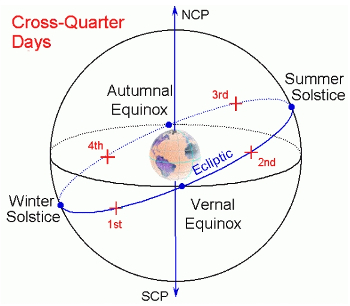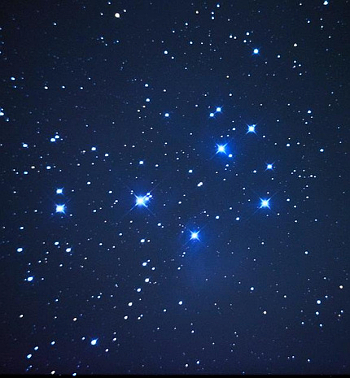EarthSky.org
 |
| NASA illustration |
| Equinoxes, solstices and cross-quarter days are all hallmarks of Earth’s orbit around the sun. Halloween is the 4th cross-quarter day of the year. |
A cross-quarter day is a day more or less midway between an equinox (when the sun sets due west) and a solstice (when the sun sets at its most northern or southern point on the horizon). Halloween – October 31 – is approximately midway point between the autumn equinox and winter solstice, for us in the Northern Hemisphere.
In other words, in traditional astronomy, there are eight major seasonal subdivisions of every year. They include the March and September equinoxes, the June and December solstices, and the intervening four cross-quarter days.
In modern times, the four cross-quarter days are often called Groundhog Day (February 2), May Day (May 1), Lammas (August 1) and Halloween (October 31).
For us in the Northern Hemisphere, Halloween is the darkest of the cross-quarter days, coming at a time of year when the days are growing shorter. Early people once said that the spirits of the dead wander from sunset until midnight around this cross-quarter day. After midnight – on November 1, which we now call All Saints’ Day – the ghosts are said to go back to rest.
The October 31 date for Halloween has been fixed by tradition. The true cross-quarter day falls on November 7, representing a discrepancy of about a week. According to the ancient Celts, a cross-quarter day marks the beginning – not the middle – of a season.
 |
| Dave Dehetre photo |
| The Pleiades star cluster, also known as the Seven Sisters. This tiny, misty dipper is easy to pick out in the night sky. |
In other words, the Pleiades climbed to its highest point in the sky at midnight on or near the same date as this cross-quarter day. In our day, Halloween is fixed on October 31, though the midnight culmination of the Pleiades cluster now occurs on November 21.
Presuming the supposed connection between Samhain and the midnight culmination of the Pleiades, the two events took place on or near the same date in the 11th century (1001-1100) and 12th century (1101-1200). This was several centuries before the introduction of the Gregorian calendar.
At that time, when the Julian calendar was in use, the cross-quarter day and the midnight culmination of the Pleiades fell – amazingly enough – on or near October 31. But, then, the Julian calendar was about one week out of step with the seasons. Had the Gregorian calendar been in use back then, the date of the cross-quarter day celebration would have been November 7.
But Halloween is now fixed on October 31. Meanwhile, the true cross-quarter day now falls on or near November 7 and the midnight culmination of the Pleiades cluster on or near November 21.